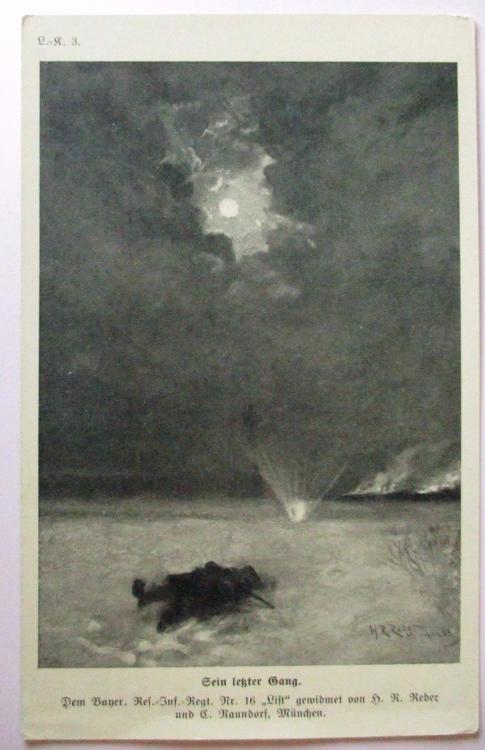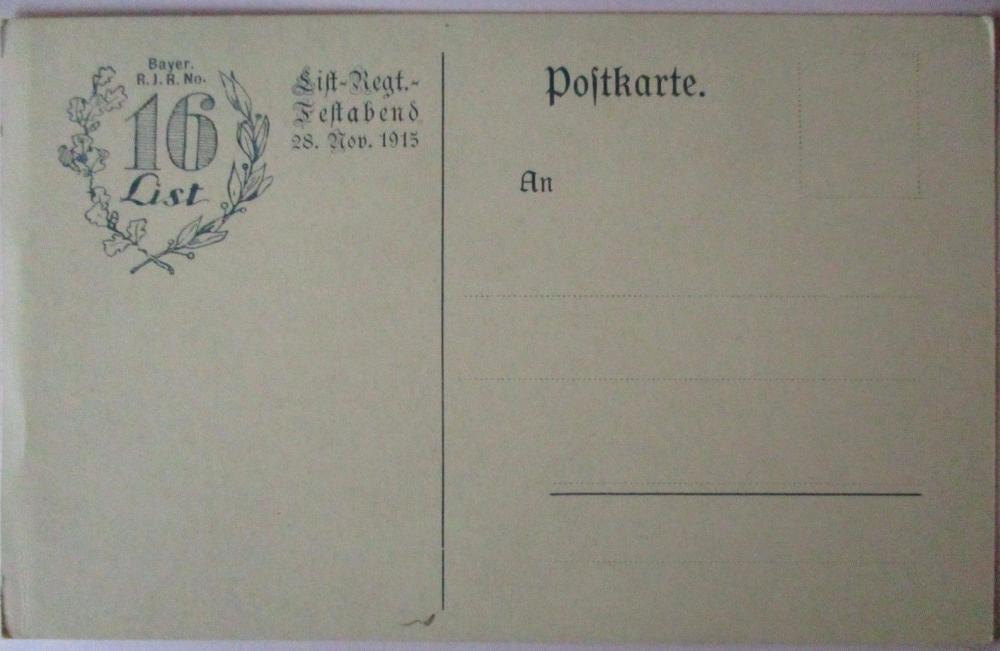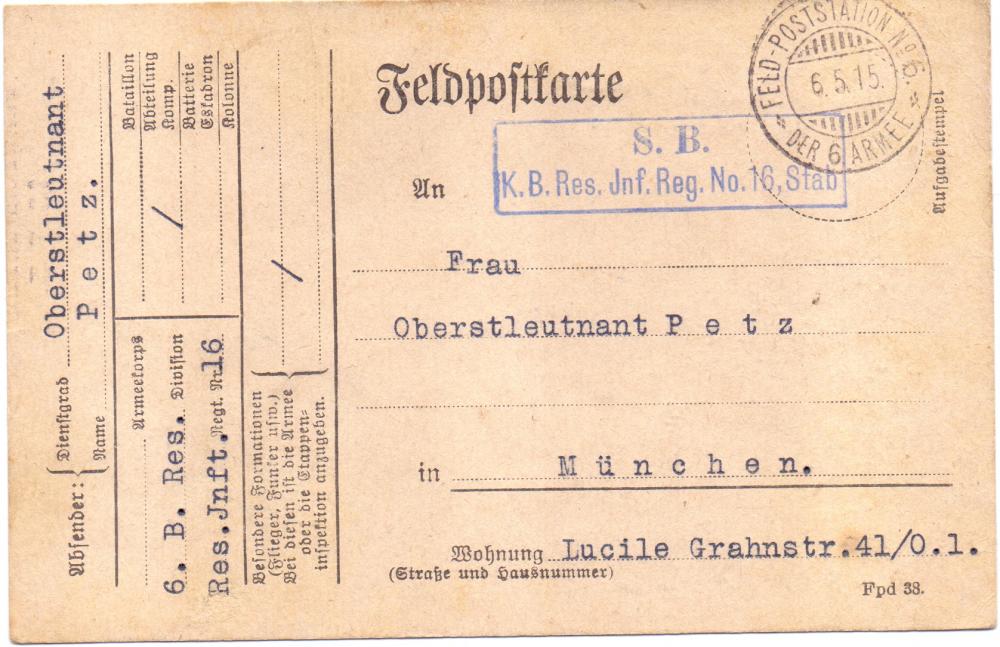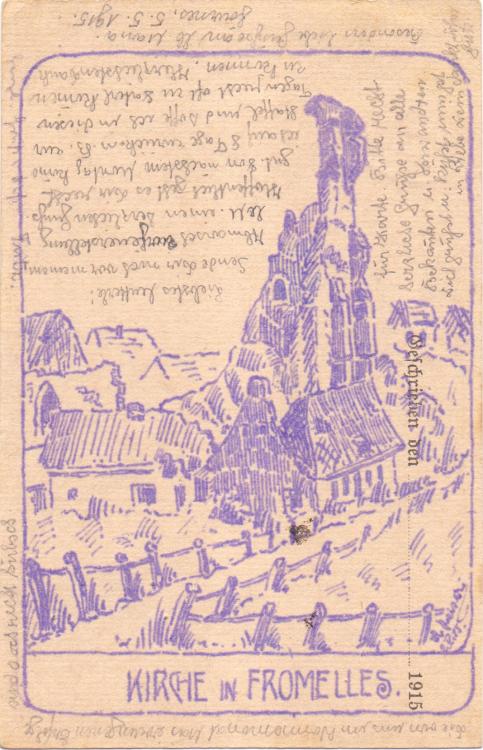-
Posts
3,101 -
Joined
-
Last visited
-
Days Won
6
Content Type
Profiles
Forums
Blogs
Gallery
Events
Store
Everything posted by The Prussian
-
And another one... The front shows a fallen soldier with the words: His last journey. Dedicated to the bavarian Res.Inf.Rgt. Nr.16 "List" from H.R. Reder and C. Raundorf, Munich The reverse: List-Regiment-celebration-evening, November 28, 1915. Unfortunately, the regimental history doesn´t mention that event.
-
Ah, ok. I think you´re right. If there is a borte (I can´t recognize), then he is Feldwebel
-
Hello! Yes, I just didn´t know, if that rank belonged to The "Non-commissioned officers"... Do you know what the thin white line close to the stars means? If he was in Inf.Rgt.63, the facing-colour was "orange-yellow". That could fit, because on b/w photos yellow colours appeared very dark (like black)
-
Hello! Thanks for the zoom! The rank on this photo is Zugsführer. The ranks are: Gemeiner (simple soldier) Gefreiter (Lance-Corporal) Korporal (Corporal) Zugsgführer (Sergeant) Feldwebel (Colour-Sergeant) By the way, the photo with the single star indicates him as a Fähnrich (Aspirant-Officer). I don´t know, if in english that´s an NCO too...
-
Ah. That's clear. Now we see the braid around the coller. It is a Fähnrich (Aspirant Officer)
-
Hello! Could I have a big scan of the collar of the soldier, please? Three stars were worn from Captains and Feldwebel. By the way: In Besztercze were 1., 2., 3. Btl. of Inf.Rgt. 63 and 2.Btl. of Landwehr-Regiment 22
-
-
Hello! In Metaljka was only a border station, no garrisson. Until 1899 in Plevlje was staff, 1., 3. and 4. bataillon of the hungarian 2nd Inf.Rgt : http://www.mlorenz.at/images/Oe-U_Garnisonen_1898.jpg Since 1899 it was in Kronstadt (Brasov) and Hermannstadt (Sibiu): http://www.mlorenz.at/images/Seidels_Armeeschema/1908/Seidels_Armeeschema_1908_042-043.jpg Here is a today´s map: https://www.google.de/maps/dir/Metaljka,+Bosnien+und+Herzegowina/Pljevlja,+Montenegro/@43.4685753,19.1860479,11.79z/data=!4m13!4m12!1m5!1m1!1s0x47586e4988767175:0x57fdbb183f60066c!2m2!1d19.156478!2d43.538586!1m5!1m1!1s0x47580844f4917229:0xe23cd955c6680a74!2m2!1d19.3512591!2d43.3582371 Here a part of the ranklist 1898:
-
Hello! Would you show it, please? The regiment came to the Somme sept. 25, 1916 (Frémicourt until october 2) October 3, Adolf got light wounded by an artillery attack on an underground way. He recieved just a few scratches. October 5 he got wounded near La Barque Here you see the regimental staff (small "flag") in La Barque (taken from the regimental history):
-
Hello Tony! It´s Militärpaß. Probably you don´t have the letter "ß" on your keyboard, so you also can use "ss" - it´s the same: Militärpass. His name is Friedrich Rohde Units: Ers.Esk. Drag.Rgt.1 6.8.17: Feldrekrutendepot Kavallerie-Schützen Regiment 89 17.11.17: 4.Esk./Kavallerie-Schützen-Regiment 18.9.18: Dragoner-Regiment 15 You are right, that he was in prison. The entry in the MP says: Vermisst bei Arleux (missed at Arleux). Arleux is northwest of Cambrai. The prison card says, he was caught at Cambrai. That fits! The Drag.Rgt,.15 belonged to 30.Kav.Brig. (later Kavallerie-Schützen-Kommando 30), 7.Kav.Div. Here are his prisoner cards:
-

Fantastic I.R. 88 EK2+1 combination
The Prussian replied to Chris Boonzaier's topic in Germany: All Eras: The Iron Cross
Hello! Thankjs for the explanations! UI found two Karl G. in the casualty lists, but none in IR88. Maybe later he served withanother unit? -

Fantastic I.R. 88 EK2+1 combination
The Prussian replied to Chris Boonzaier's topic in Germany: All Eras: The Iron Cross
Hello Chris! Very interesting papers! Walter Rogge was commander from 18.2.15-8.10.18 But why were the documents dated in march 1916, although he recieved the crosses in sept. 14 and march 15? -

"Strich-Dauerfeuer" meaning?
The Prussian replied to dksck's topic in Deutsche Kaiserreich: Man spricht Denglish
Hello! Dauerfeuer means continuous or sustained fire. Strich means line. I haven´t heard the word "Strich-Dauerfeuer", but to me it means, a MG fires into an area from left to right and back to the left -

Soldier French Foreign Legion 1st Reg. 1890s Sidi Bel Abbes
The Prussian replied to GreyC's topic in France
Hello! Yes, it´s a fantasctic photo! Please note the number 1 at the collar. The 1st and 2nd regiment became one regiment in 1862. In december 1884 it was divided in 1st and 2nd again. The book "Uniforms of the French Foreign Legion" (Martin Windrow) says: "In december 1884 the formation of the 1st and 2nd RE led to the addition of regimental numbers to the "bombs of officers and warrant officers collar grenades, though not to that on the képi. The troops acquired numbers on their collars - blue on tunics, red on vestes and capotes. In february 1885 epaulettes were suppressed throughout the army, the order being rescined in january 1887. It seems that the Legion may have ignored this order; but from 1886 they wore the red and green epaulettes only for major parades and reviews." "It was in the mid-1890s that the Gras single-shot rifle was progressively replaced by the new 8mm Lebel magazine rifle." So to me, the earliest date of that photo could be 1886 -
Here is a little bit about his unit. Since june 1919 the LIR became 1.bayer. RW-Schützen-Regiment 41 München (I. and III.Btl. München, II.Btl. Rosenheim) In october 1919 it became: RW-Schützen-Regiment 41 München (I.Btl. München, II.Btl. Passau, III.(Jäger) Btl.Landshut Later: 19.(bayer.) Inf.Rgt. München (I.Btl. München, II.Btl. Augsburg, III.Btl. Kempten and Lindau, Ers.Btl. Landshut Note that he wrote: Bayer. Jäger-Bataillon 41 What he means is: III.(Jäger) Btl./Reichswehr-Schützen-Regiment 41



.thumb.jpg.7a27c4480c75b179d2d339561f2ee841.jpg)
.jpg.f5d8e1a8f9cbdbfcc934877a0cadb108.jpg)
.thumb.jpg.2b9ed8ae28ba9687e27ea6cddb6e0783.jpg)
.jpg.ee0fbb947ea4421d6825e37024a0c898.jpg)
.thumb.jpg.9b8577d207413e4daf2a0a92ff8fc42c.jpg)
.thumb.jpg.7558a1a46ad9ce4daf8535c8effc581a.jpg)

